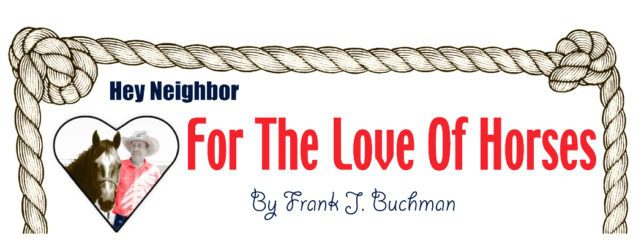More and more people don’t want the horses they have, and, with that, the neglect and abuse of horses are increasing.
Dr. Douglas G. Corey, recently elected chairman of the Unwanted Horse Coalition, made that emphasis in detailing findings from his group’s study on Contributing Factors Surrounding the Unwanted Horse Issue.
A Walla Walla, Washington, veterinarian who has devoted much of his attention to horse welfare issues, Corey helped the Professional Rodeo Cowboy’s Association develop minimum-care guidelines for rodeo livestock.
“Since formation of the Unwanted Horse Coalition, great strides and accomplishments have been made in the education and awareness of the issue of unwanted horses,” Corey stated. “With a new plan in place, we can continue our efforts and progress to make more of a difference for these horses in the equine
community.”
The recently completed study was the first of its kind to assess the causes and magnitude of the unwanted horse population in the United States.
“More than 87 percent of respondents indicated that the issue of unwanted horses had become ‘a big problem’ in the past year, compared with only 22 percent who said the problem was important three years ago,” Corey emphasized.
In light of one of the worst fiscal downturns in U.S. history, the economy was considered to be a significant contributor to the unwanted horse problem.
Other major contributors cited by the respondents included: closing of the nation’s processing facilities, changes in breed demand, indiscriminate breeding, high costs of euthanasia and carcass disposal.
“Of the equine rescue and retirement facilities that were polled, more than 65 percent
reported that they were at near or full capacity and, on average, turn away 38 percent of the horses brought to them,” Corey pointed out. “Capacity is clearly the issue in that almost as many horses stay for life as are adopted out.”
The Unwanted Horse Coalition (UHC) grew out of a 2005 American Association of Equine Practitioners (AAEP) initiative, and is currently under the umbrella of the American Horse Council (AHC). It is financially supported by participating AHC organizations and is focused on education, communication and responsible ownership.
Participating organizations include national, regional and local associations of
veterinarians, breed registries, horse associations, breeders, performance groups, owners and equine publications.
Mission statement of the Unwanted Horse Coalition is: “To effectively reduce the
number of unwanted horses in the United States, and to improve their welfare through education and the efforts of organizations committed to the health, safety and responsible care of the horse.”
Unwanted horses are defined as: “Horses which are no longer wanted by their current owner, because they are old, injured, sick, unmanageable, fail to meet their owner’s
expectations in performance, color or breeding, or their owner can no longer afford them.”
From the beginning, the intent of theUnwanted Horses Surveywas to gather projectable national metrics that would be useful in identifying and/or creating solutions to the problem. The way to do this would be to engage anyone and everyone involved with horses, as well as the general public.
The Internet was used as the most expedient vehicle to gain quick and cost-effective feedback from the many different people affected by, and involved with, horses on a nationwide scale.
Other noted contributors to the problem include: inability to sell horse, lack of buyers,
age of horse owner, physically unable to care for the horse, lack of responsibility and attitude of owner.
Four possible solutions to the problem emerged as most appealing by the respondents were to educate owners to purchase and own responsibly, increase ability of private rescue and retirement facilities to care for unwanted horses, reopen U.S. processing plants, and increase options and resources to euthanize unwanted
horses
Solutions viewed as leastappealing by the respondents included: expand legislation or regulation to control horse ownership, secure federal funding for carcass removal, increase awareness of animal welfare rights and secure federal funding to expand horse adoption.
Hundreds of write-in comments from respondents support the spread of neglect and abuse with reports of horses being: “Left to starve, abandoned or shot by owners,” “Tied to a stranger’s trailer,” “Just turned loose to fend for themselves,” “Starved to death,” “Abandoned,” and “Just left to die without food or water.”
“To fully understand the financial impact of the unwanted horse problem, it’s imperative to look at the current situation faced by rescue, retirement, adoption and retraining facilities,” Corey noted.
With an average annual budget need of $2,300 to care for one horse, the industry will need a minimum of $25.7 million just to care for the horses that are currently being turned away.
“The magnitude of the problem appears to be staggering,” Corey evaluated. “It is further complicated by the intensity of different viewpoints and opinions throughout the horse industry.”
As with nearly everything related to horses, there are strongly held opinions, from many viewpoints, about the causes of horses being unwanted.
“There is also equally strong concern about the problem reported on all sides, and a
willingness indicated to assist with solutions,” Corey stated. “Horse owners claim they are willing to donate money, and this may bring in much of the necessary
support for rescue, adoption and other programs.”
While the study demonstrated a marked disparity in opinions about whether or not the processing plants should be reopened, the industry is united in addressing and resolving the unwanted horse problem.
“Many support the reopening of processing plants; however, this is a matter for federal and state officials,” Corey clarified.
“Regardless of what happens at the legislative level, the horse industry still faces the problem of unwanted horses, and the Unwanted Horse Coalition will continue to pursue its mission of educating the horse industry and general public about responsible horse ownership,” Corey concluded.
+++
